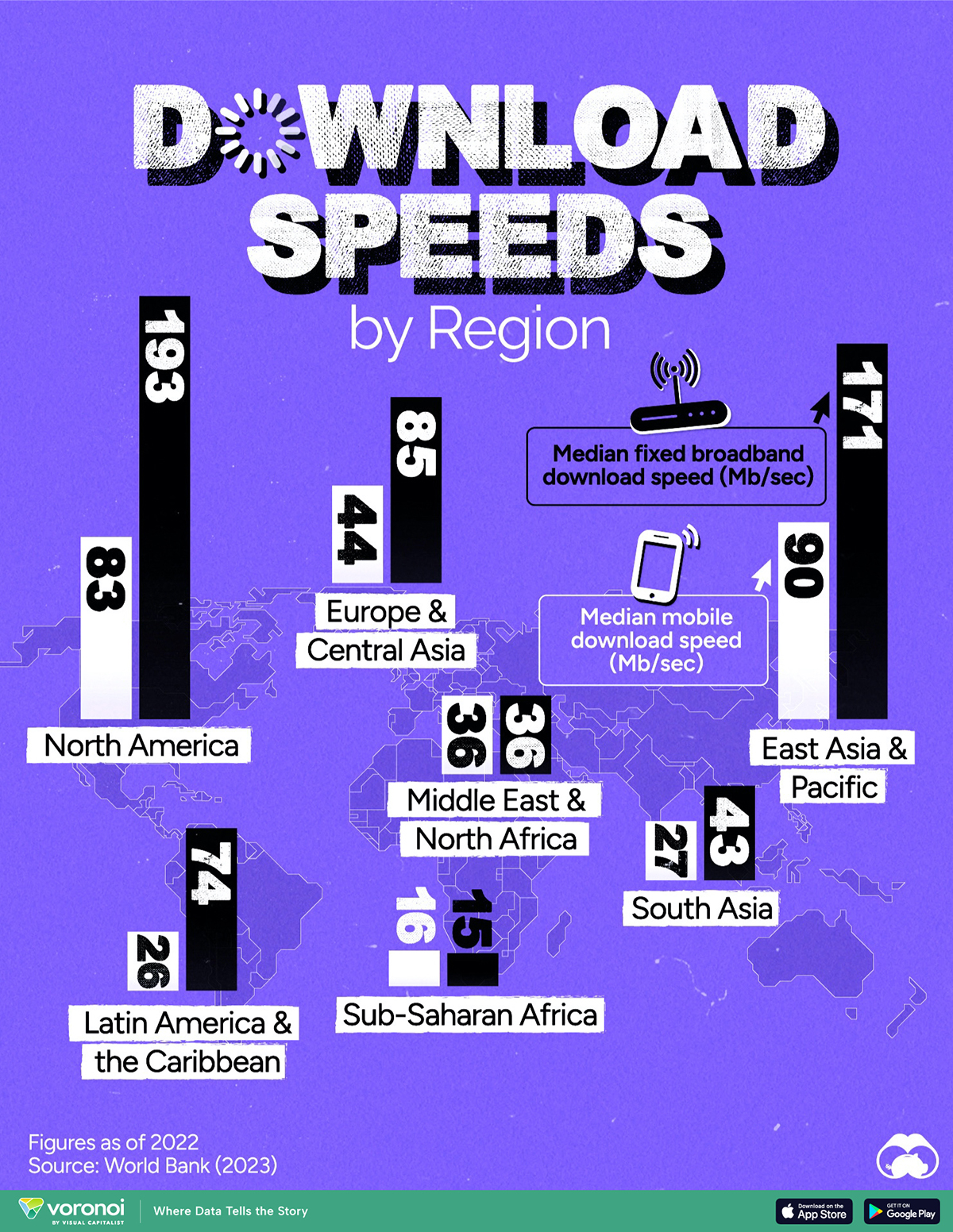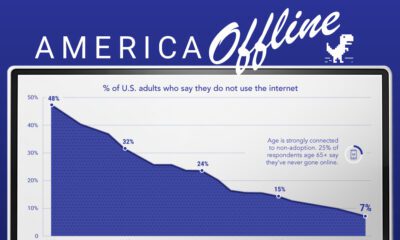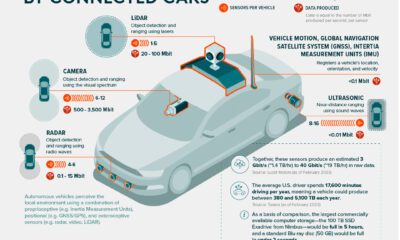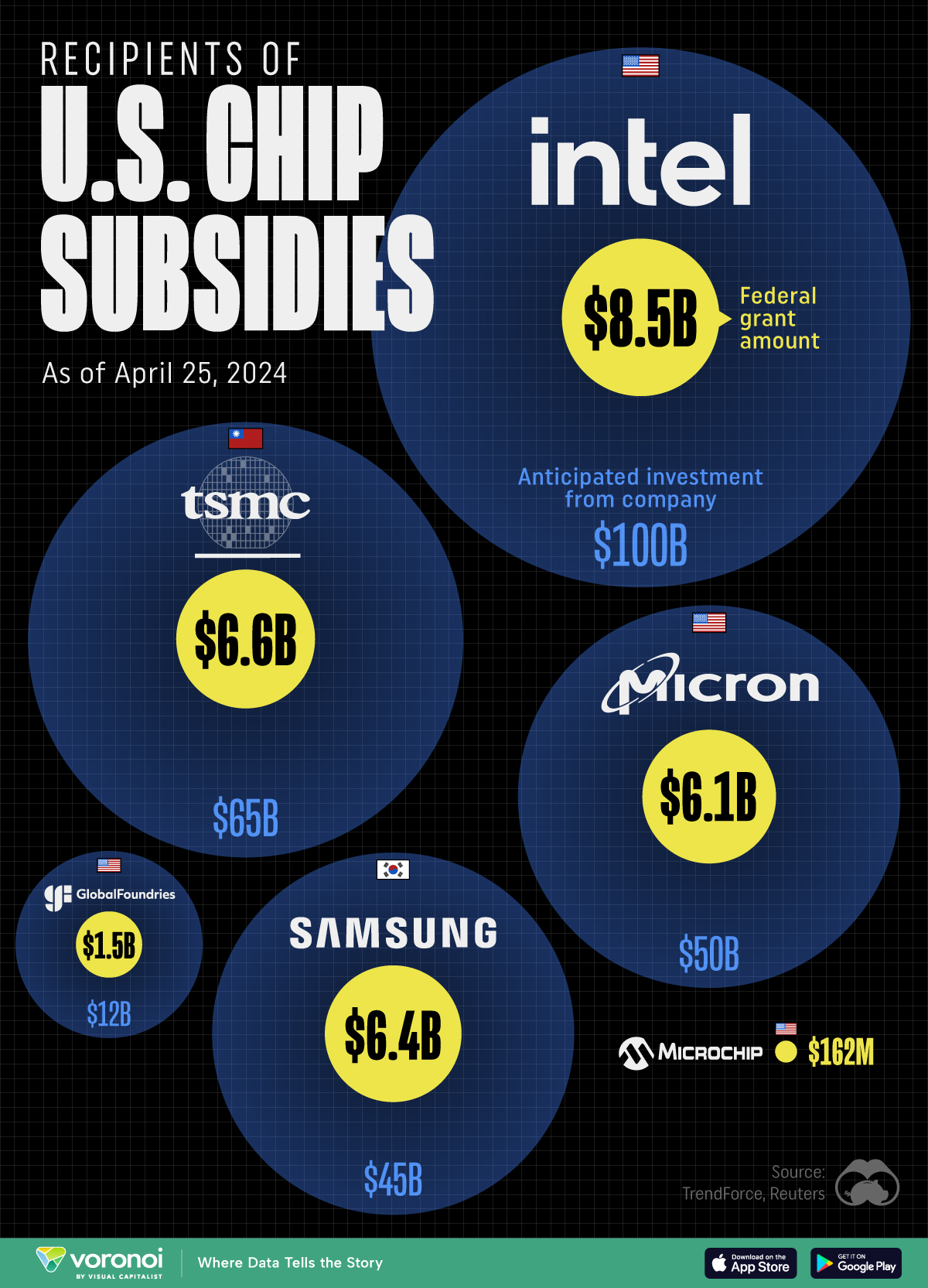Technology
Mapped: Internet Download Speeds by Region
![]() See this visualization first on the Voronoi app.
See this visualization first on the Voronoi app.
Mapped: Internet Download Speeds by Region
This was originally posted on our Voronoi app. Download the app for free on iOS or Android and discover incredible data-driven charts from a variety of trusted sources.
In today’s fast-paced world, internet speed isn’t just a convenience—it’s the driving force behind how we work, play, and connect.
In this map, we illustrate median download speeds in each global region, based on data from the World Bank’s Digital Progress and Trends Report 2023.
North America and East Asia Have the Speediest Internet
According to the World Bank, download speeds in high-income countries increased significantly between 2019 and 2023, while speeds in lower-income countries stagnated.
As of 2022, North America and East Asia have the speediest internet.
| Region | Median mobile download speed (Mb/sec) | Median fixed broadband download speed (Mb/sec) |
|---|---|---|
| East Asia & Pacific | 90 | 171 |
| Europe & Central Asia | 44 | 85 |
| Latin America & the Caribbean | 26 | 74 |
| Middle East & North Africa | 36 | 36 |
| North America | 83 | 193 |
| South Asia | 27 | 43 |
| Sub-Saharan Africa | 16 | 15 |
This difference in broadband speeds can mainly be attributed to investment.
In 2020, nearly 90% of global telecommunication investment came from East Asia and the Pacific, Europe and Central Asia, and North America. These regions not only concentrate the highest-income population but also the top technology hubs.
Meanwhile, low- and middle-income regions such as Latin America and the Caribbean, South Asia, and Sub-Saharan Africa accounted for less than 10% of total investment.
Most of the investment is directed towards fiber optic and 5G mobile networks. According to the mobile industry association GSMA, mobile operators alone are projected to invest more than $600 billion between 2022 and 2025, with 85% of the total allocated for 5G.
In 2023, broadband speeds in high-income countries were 10x faster for fixed connections, and 5x faster for mobile connections compared to those in low-income countries.
Fixed broadband connections, which provide high-speed internet to residences or businesses, reached 38% of the population in high-income countries. In comparison, fixed broadband penetration was only 4% of the population in lower-middle-income countries and almost zero in low-income countries.
Technology
All of the Grants Given by the U.S. CHIPS Act
Intel, TSMC, and more have received billions in subsidies from the U.S. CHIPS Act in 2024.
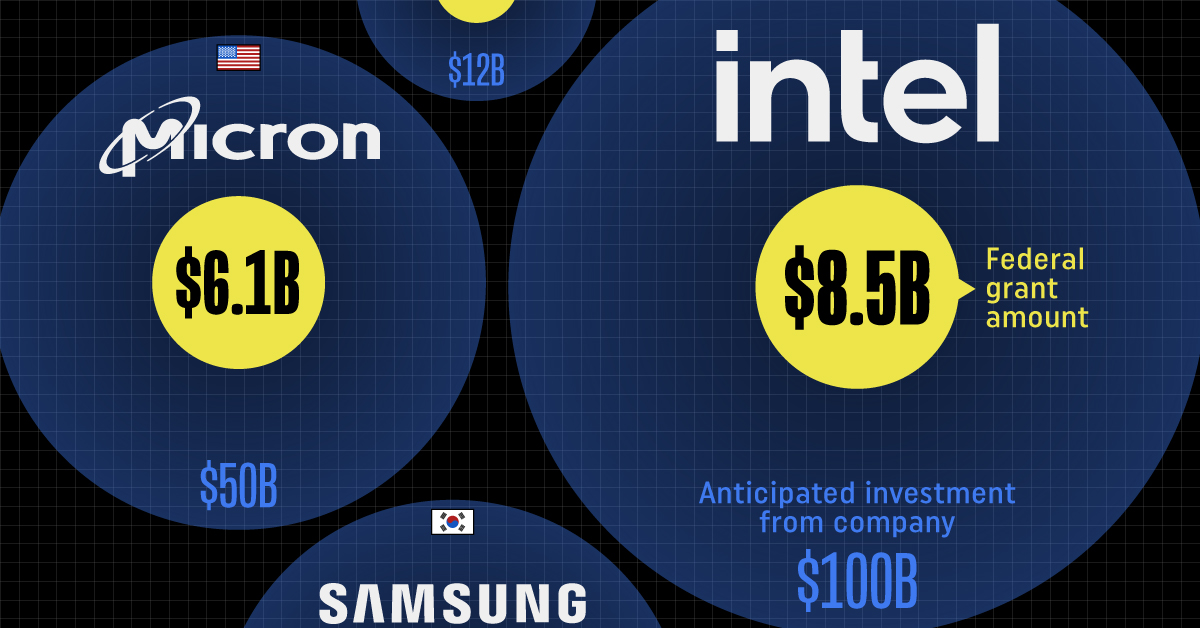
All of the Grants Given by the U.S. CHIPS Act
This was originally posted on our Voronoi app. Download the app for free on iOS or Android and discover incredible data-driven charts from a variety of trusted sources.
This visualization shows which companies are receiving grants from the U.S. CHIPS Act, as of April 25, 2024. The CHIPS Act is a federal statute signed into law by President Joe Biden that authorizes $280 billion in new funding to boost domestic research and manufacturing of semiconductors.
The grant amounts visualized in this graphic are intended to accelerate the production of semiconductor fabrication plants (fabs) across the United States.
Data and Company Highlights
The figures we used to create this graphic were collected from a variety of public news sources. The Semiconductor Industry Association (SIA) also maintains a tracker for CHIPS Act recipients, though at the time of writing it does not have the latest details for Micron.
| Company | Federal Grant Amount | Anticipated Investment From Company |
|---|---|---|
| 🇺🇸 Intel | $8,500,000,000 | $100,000,000,000 |
| 🇹🇼 TSMC | $6,600,000,000 | $65,000,000,000 |
| 🇰🇷 Samsung | $6,400,000,000 | $45,000,000,000 |
| 🇺🇸 Micron | $6,100,000,000 | $50,000,000,000 |
| 🇺🇸 GlobalFoundries | $1,500,000,000 | $12,000,000,000 |
| 🇺🇸 Microchip | $162,000,000 | N/A |
| 🇬🇧 BAE Systems | $35,000,000 | N/A |
BAE Systems was not included in the graphic due to size limitations
Intel’s Massive Plans
Intel is receiving the largest share of the pie, with $8.5 billion in grants (plus an additional $11 billion in government loans). This grant accounts for 22% of the CHIPS Act’s total subsidies for chip production.
From Intel’s side, the company is expected to invest $100 billion to construct new fabs in Arizona and Ohio, while modernizing and/or expanding existing fabs in Oregon and New Mexico. Intel could also claim another $25 billion in credits through the U.S. Treasury Department’s Investment Tax Credit.
TSMC Expands its U.S. Presence
TSMC, the world’s largest semiconductor foundry company, is receiving a hefty $6.6 billion to construct a new chip plant with three fabs in Arizona. The Taiwanese chipmaker is expected to invest $65 billion into the project.
The plant’s first fab will be up and running in the first half of 2025, leveraging 4 nm (nanometer) technology. According to TrendForce, the other fabs will produce chips on more advanced 3 nm and 2 nm processes.
The Latest Grant Goes to Micron
Micron, the only U.S.-based manufacturer of memory chips, is set to receive $6.1 billion in grants to support its plans of investing $50 billion through 2030. This investment will be used to construct new fabs in Idaho and New York.
-

 Debt1 week ago
Debt1 week agoHow Debt-to-GDP Ratios Have Changed Since 2000
-

 Markets2 weeks ago
Markets2 weeks agoRanked: The World’s Top Flight Routes, by Revenue
-

 Countries2 weeks ago
Countries2 weeks agoPopulation Projections: The World’s 6 Largest Countries in 2075
-

 Markets2 weeks ago
Markets2 weeks agoThe Top 10 States by Real GDP Growth in 2023
-

 Demographics2 weeks ago
Demographics2 weeks agoThe Smallest Gender Wage Gaps in OECD Countries
-

 United States2 weeks ago
United States2 weeks agoWhere U.S. Inflation Hit the Hardest in March 2024
-

 Green2 weeks ago
Green2 weeks agoTop Countries By Forest Growth Since 2001
-

 United States2 weeks ago
United States2 weeks agoRanked: The Largest U.S. Corporations by Number of Employees

